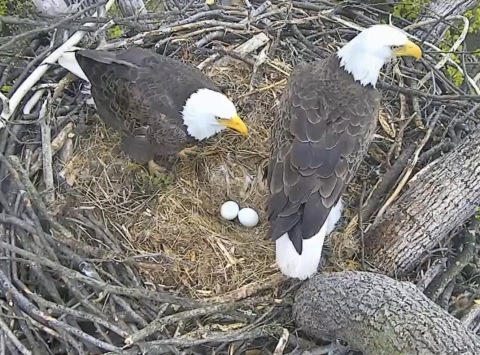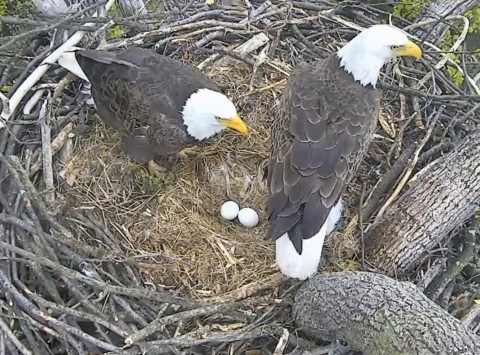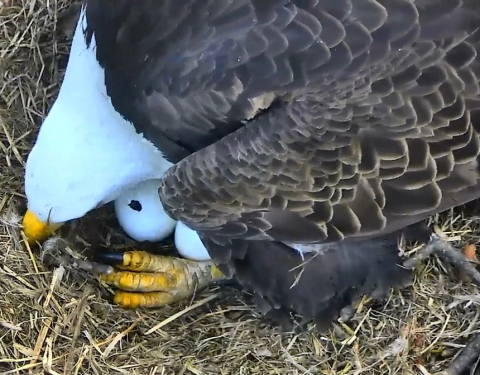WASHINGTON--(BUSINESS WIRE)--Viewers around the globe are on 'egg pip and hatch watch' as they anticipate the hopeful arrival of two adorable bald eaglets in the nation’s capital.
The millions of viewers who have become addicted to watching bald eagles “Mr. President” and “The First Lady” on the DC Eagle Cam (https://dceaglecam.org) may want to keep their eyes glued to their computer screens beginning this weekend to hopefully see their first egg begin to "pip" and see two fuzzy eaglets emerge from their eggs. The first pip may happen as early as Sunday.
“Each eaglet has an 'egg-tooth' on the tip of its upper beak, which is used to crack holes in their eggshell from the inside,” said American Eagle Foundation President Al Cecere. “The first hole made in the shell is called a 'pip.’ It sometimes takes up to 24-48 hours for an eaglet to fully emerge from its shell after the first pip.”
The first egg was laid on March 25 at 4:30 p.m. and the second was laid on March 28 at 2:46 p.m. Because the average incubation period for an eagle egg is 35 days, the AEF expects the first eaglet to begin pipping or hatching around Sunday, April 29, with the second beginning to pip or hatch around May 2. This is just an estimate, however, and may vary by a day or two.
“The amazement of watching a tiny eaglet emerge from its fragile egg shell is a miraculous wonder of nature,” says Cecere. “Watching the eagle parents delicately feeding and brooding their young is a very special and unforgettable experience not to be missed.”
Once hatched, these two eaglets will (for now) be called DC6 and DC7, as these will be the sixth and seventh eaglets hatched and raised in this nest located at the top of a Tulip Poplar Tree in the U.S. National Arboretum in Washington, DC.
Since 2016, the cams have been viewed more than 65 million times in more than 100 countries.
ABOUT THE D.C. EAGLE CAM PROJECT
In 2015, the American Eagle Foundation (WWW.EAGLES.ORG) staff traveled to the USDA's National Arboretum in D.C. to propose the idea for the DC Eagle Nest Cam project and to later install state-of-the-art video cameras (pan-tilt-zoom), infrared lighting, and other related equipment in and around a bald eagle nest tree inside the Arboretum with the help of AEF and Arboretum staff, volunteers, and experienced tree arborists/climbers. In early 2016, the USDA’s National Arboretum ran a half-mile of fiber optic cable from a video camera ground control station box, allowing camera images to access the Internet. During the Summer and Fall of 2016, the AEF team installed new microphones and upgraded video cameras above the nest to further enhance the viewing and listening experience. Also, a team of tree climber arborists and eagle experts affixed natural tree limbs beneath the nest to provide added structural support. Since early 2016, the entire cam, lighting and microphone system has been powered by a large mobile solar panel array (containing several deep cycle batteries) that was designed, built and installed by students and staff from Alfred State College, SUNY College of Technology and was partially funded by the Department of Energy and Environment. USNA has implemented a backup generator that will kick on if prolonged inclement weather causes the solar array to provide insufficient power to the system. In the Fall of 2016, APEX Electric Inc. (Kenmore, Washington) traveled to D.C. to assist the AEF in successfully installing new cameras and microphones (and related audio equipment) in and around the nest tree. The AEF uses Piksel to stream the high quality video images to viewers around the World, and AEF volunteers are trained and coordinated to pan, tilt and zoom the cams (from remote locations), as well as educate the public through LIVE chats while viewers watch the eagles via the cams on the Internet. School classrooms often schedule time on the chat during school hours. The DC Eagle Nest Cam Project has garnered media interest and coverage around the U.S. and the world, continuing to be one of the most popular and watched animal cams on the Internet.



